
Super Bowl MVP - Most Valuable Protector

During Super Bowl LII, the Philadelphia Eagles’ and New England Patriots’ offenses put up a record-setting total number of yards and a plethora of points. The Eagles soared to a 41-33 win. Outside the stadium in Minneapolis, defense ruled the day, and U.S. Customs and Border Protection played a key role in a multi-agency effort that brought together federal, state and local officials.
"The other bird is at your 8 o’clock and close," said the sensor operator in an AS350 helicopter, better known as the AStar, circling the stadium in downtown Minneapolis just a few days before the big game. "Got it," the pilot quickly shot back, showing full situational awareness of airspace around the stadium.
About 65 AMO personnel and six aircraft – three UH-60 Black Hawk and three AStar helicopters – worked the Super Bowl this year. They were part of a larger 150-plus force of AMO agents and officers, Border Patrol agents, CBP officers, import specialists and others from CBP locations all around the country.
"We had people from Baltimore to California on the job in and around Minneapolis," said Chief Patrol Agent Douglas Harrison, the lead field coordinator for CBP operations at the Super Bowl. The diversity of the mission, whether it was security, law enforcement or intellectual property rights protections – and the chance to interact with other federal, state and local law enforcement – gave his team much to draw upon for their regular duties back at the ports and along America’s borders. "Every operation brings a new experience to the table. We all learn from each other."
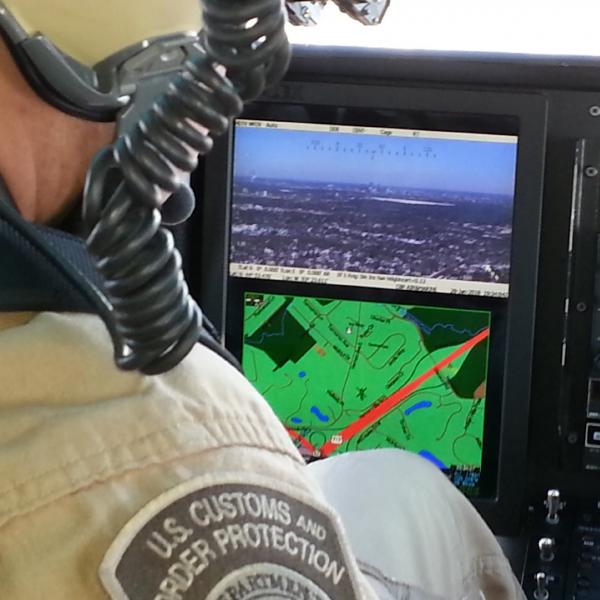
An image operator looks at the live video stream of the scene below near this year’s Super Bowl site in Minneapolis. Photo by John Davis
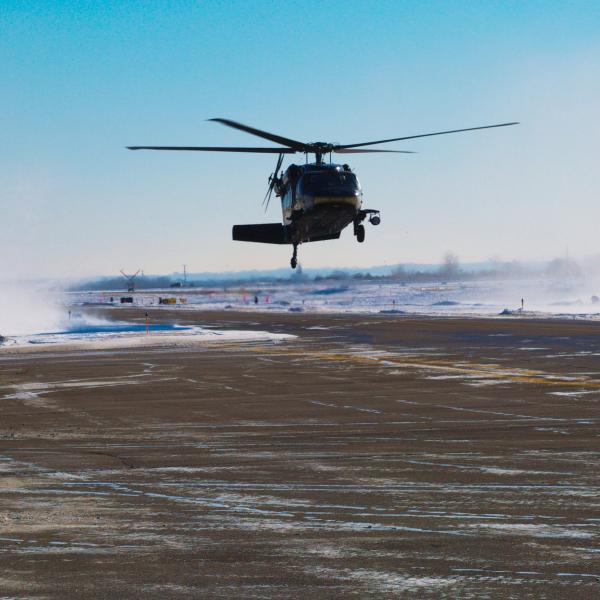
A CBP UH-60 Black Hawk helicopter kicks up a dusting of snow that fell the night before during sub-zero temperatures at an airfield just outside of Minneapolis. Photo by Kris Grogan
In the air, AMO had two main missions: be the eyes in the sky and help keep the air space around the stadium safe.
"We provided an aerial downlink with cameras mounted on our birds feeding live video back to the joint operations centers back on the ground, as well as providing that extra level of air security," said Jonathan Johnson, a supervisory air interdiction agent at a small airport just a few minutes flying time from downtown Minneapolis. "The people back on the ground can ask for our AStar operators to provide video of a particular part of the city. We can check out a suspicious vehicle or people and eliminate any questions of what’s happening on the ground."
The job of keeping the helicopters air-worthy fell to the maintenance teams.
"We need to keep these birds flying," said Matt Swazey, a contract aircraft mechanic from Detroit. "We’re keeping them safe, because our aircrews have an important mission to support. And we’re here to support them."
AMO was in the area for about a week and a half before Super Bowl Sunday, patrolling the area. On game day, the Black Hawk crews detected, tracked and coordinated the interdiction of aircraft violating a temporary no-fly zone for miles around the stadium. If any aircraft violated that air space, CBP was ready to intercept. CBP, the Department of Defense, other federal assets and local law enforcement had been planning and coordinating security for more than a year.
"This is a large puzzle with a lot of moving parts," Johnson said.
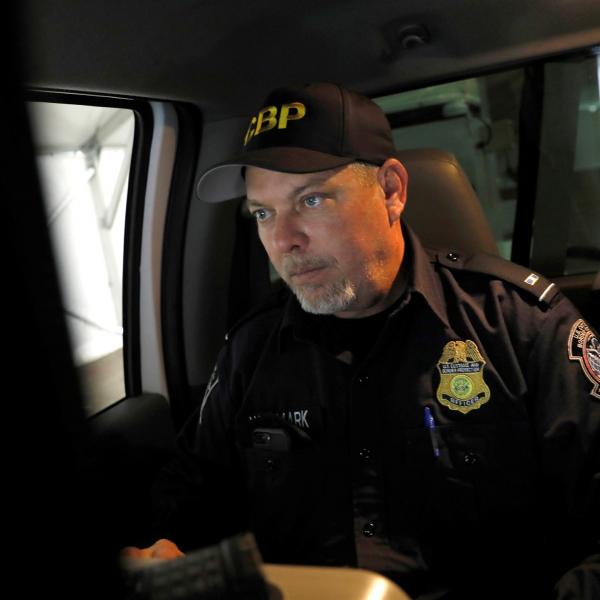
CBP Officer Anthony Hallmark reviews an X-ray image of a truck that was just scanned during non-intrusive inspections on commercial vehicles destined for the stadium. Photo by Glenn Fawcett
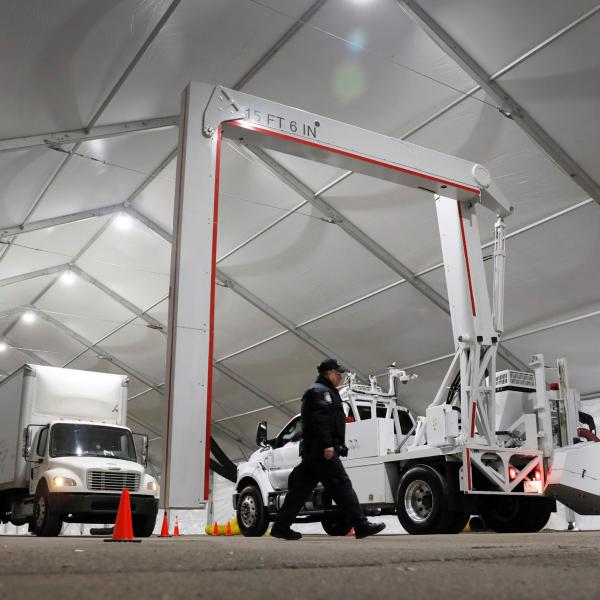
CBP officers conduct X-ray inspections on commercial vehicles destined to deliver provisions and equipment for Super Bowl LII in Minneapolis, Jan. 30. Photo by Glenn Fawcett
In the run-up to the game, CBP screened thousands of vehicles that carried in the food, souvenirs, high-definition television equipment and fans to celebrate this year’s Super Bowl.
It’s a process made quicker and easier with CBP’s non-intrusive inspection equipment. A large X-ray machine for semitrailers is used, while a smaller, more mobile version of the same technology mounted on the back of a truck is used to scan personal vehicles, delivery vans and recreational vehicles.
"We scan vehicles coming in for explosives, weapons and anything that might look out of place,’" said James Askin, a CBP officer from the Port of Newark, New Jersey, operating inspection equipment in the back of a giant X-ray truck under a tent at the Minnesota State Fairgrounds, just a few miles from the stadium. "Nothing gets in without our thumbs-up."
"These machines basically take an X-ray of a vehicle," said Gerald Durand, a CBP watch commander at the Minneapolis Service Port. "That saves us a great deal of time, allowing us to search each vehicle in just seven to ten minutes," an important aspect when you consider the hundreds of vehicles that the port of entry checks every day.
The large X-ray machine scans both sides of large items, including semis and cargo containers and usually is used at ports of entry. It’s able to detect anything from big, hidden compartments down to small packages or even something as small as a handgun. It even detects people being smuggled in a trailer or vehicle.
The smaller, vehicle-mounted scanner does basically the same thing, but fits in a box on the back of a truck and scans just one side of a vehicle. It works well in the cold, perfect for the Super Bowl’s cold weather location this year.
"The operators and their experience – knowing what to look for and knowing what doesn’t look right – really makes the difference in identifying what’s in a shipment," Durand said, adding that once some kind of anomaly is found, it’s up to CBP officers on the ground to dig in and find it.
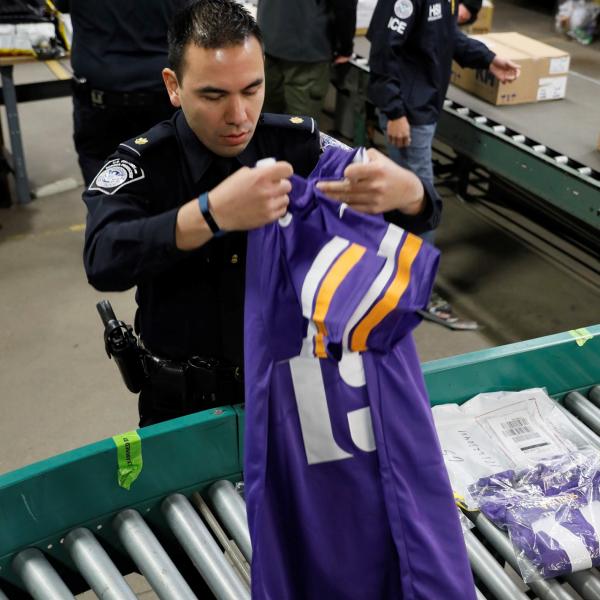
Lee Takaki, a supervisory CBP officer in Minneapolis, examines a counterfeit Minnesota Vikings jersey at an express consignment carrier facility not far from the site of Super Bowl LII, Jan. 29. Photo by Glenn Fawcett

Recently confiscated counterfeit Super Bowl rings rest in the palms of a CBP officer in Minneapolis, Jan. 31. Photo by Glenn Fawcett
Long before the trucks arrived in the northern city, CBP was protecting the intellectual property rights of merchandise on its way to the big game.
"See, look at the stitching here," said Helene Warren-Cutler, a senior import specialist with more than 30 years’ experience sent from Philadelphia as part of CBP’s Apparel, Footwear and Textile Center of Excellence and Expertise. Working at an express consignment center near the Minneapolis airport, she’s looking at a knock-off of a Philadelphia Eagles jersey, and the facility is just a stone’s throw from the site of this year’s Super Bowl. "It’s all uneven, and you can see the leftover paper between the spaces on the backside of the lettering."
She also noticed a shirt collar label that’s not even close to what is on officially licensed National Football League merchandise. Even the holographic NFL label on the paper tag doesn’t look quite right. The holographic image doesn’t reflect as it should under a scanner, so even that tag is a fake. This jersey hit the trifecta of telltale signs: bad stitching, bad label, and bad hologram.
During the past year, CBP has partnered with U.S. Immigration and Customs Enforcement-led Operation Team Player, a crackdown on counterfeit sports apparel and merchandise imports. In a news conference just days before the game, DHS officials announced that in the past year they seized more than 170,000 counterfeit sports-related items worth an estimated $15.69 million, and joint investigations led to 65 arrests with 24 convictions. In addition, CBP has launched a public awareness campaign in airports around the country, displaying ads in passenger terminals with messages to warn travelers about the dangers of purchasing counterfeit goods.
"Disrupting the sale of counterfeit merchandise and counterfeit tickets helps ensure an authentic game day experience for all fans," said NFL Vice President of Legal Affairs Dolores DiBella. "The NFL remains committed to consumer protection efforts year-round, and this collaboration with law enforcement is essential for every organization engaged in the fight against counterfeiting."
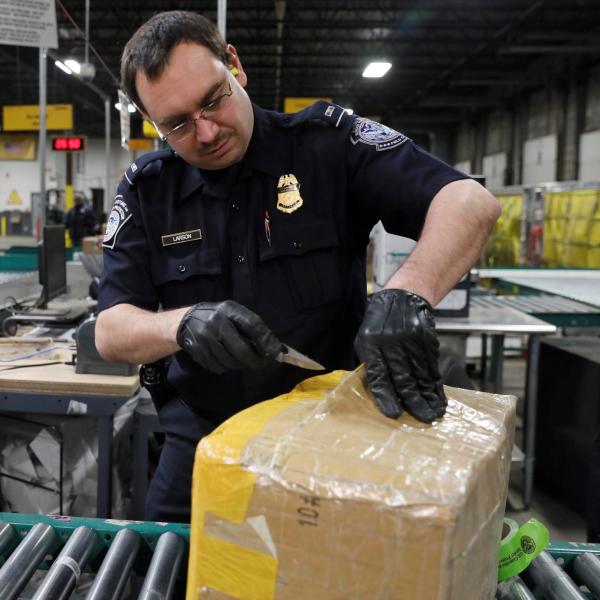
Brian Larson, a CBP officer from Minneapolis, goes through packages at an express carrier consignment facility near the site of this year’s Super Bowl. Photo by Glenn Fawcett
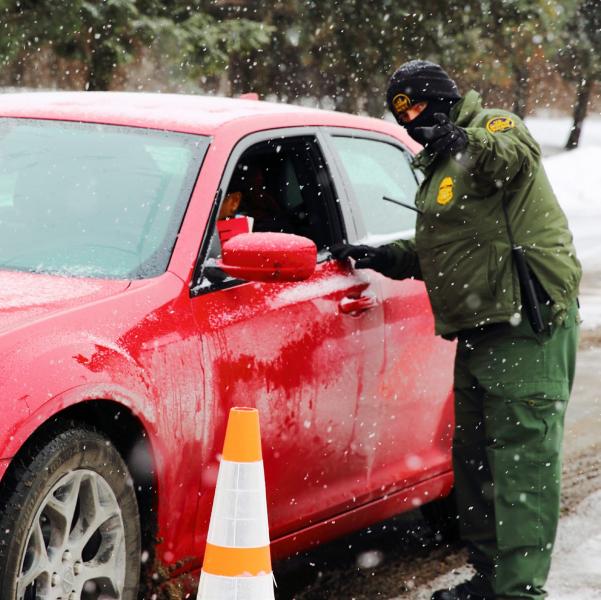
With snow falling and temperatures near zero, a U.S. Border Patrol agent from Laredo, Texas, directs a driver to a secure area so the car can be scanned by a CBP non-intrusive inspection truck before entering the Super Bowl stadium area on Feb. 4. Photo by Kris Grogan
Long before any of the merchandise hits the vendors’ tables in Minneapolis – and even before it arrives at the express shipper in the Twin Cities – CBP has people checking its authenticity when it first arrives in the U.S. Bob Redes, the acting assistant port director for trade operations at New York’s JFK Airport, said the first and second clues that something is fake could be where it’s coming from and where it’s going. It’s what helped tip off Warren-Cutler to check the package in the first place.
"The No. 1 way we target and look for counterfeit goods is looking at the country of origin – China, Hong Kong," Redes said. If a large quantity of items, such as jerseys – the top counterfeit item among NFL merchandise – are going to a private residence, then that’s another sign. "If it’s a lot going to an apartment or house, we’ll hold something like that to see what it is."
Another clue is its value.
"People might be paying five to ten dollars apiece for a counterfeit NFL championship ring," said Philip Spataro, chief CBP officer at the Miami International Mail Facility. "The real rings have diamonds or rubies and gold, so you’re not going to see a real one that cheap."
Spataro added some legitimate merchandise only comes into specific ports. So if, for example, a Super Bowl hat comes through his facility and it’s supposed to come through only at the Port of New Orleans, that’s another sign it’s probably a fake.
Redes said interrupting the flow of phony goods also interrupts the flow of cash for criminal and even possibly terrorist operations. He said his office at JFK takes probably $40 million worth of counterfeit merchandise off the streets each year. "There’s a lot of money that can be made in counterfeiting. We’re on the frontline of protecting intellectual property rights."
Across the country, CBP made more than 34,000 seizures of counterfeit goods last year, worth nearly $1.2 billion.
CBP leadership recognized the teamwork.
"Collaborative efforts like Operation Team Player put the health and safety of the American people and the vitality of our economy first," said CBP Commissioner Kevin McAleenan. "CBP is proud to partner with ICE, the Intellectual Property Rights Center and local authorities to ensure businesses and consumers are protected from intellectual property thieves."
As kickoff approached, 40 Border Patrol agents from around country came to Minneapolis to help provide an extra layer of security, working with local police departments. Agent Dan Reed from Detroit was one of those assigned to ride along on and secure the buses that took fans from the official NFL pre-game tailgating party to the stadium.
"We transferred about 9,000-10,000 people," Reed said. "There were agents posted on every bus for several hours before the game. During the game, we provided perimeter security outside the stadium."
Living and working in the Border Patrol’s Detroit sector, Reed is no stranger to the cold, although the 5-below-zero temps by the end of the game made for a bone-chilling workday, even for him. His fellow agents from southern regions, such as Texas and Arizona, were shocked by what was reported to be the coldest Super Bowl site in history (although the actual game was played inside). But the reception from fans of both the Eagles and Patriots did a lot to warm their hearts.
"There was a ton of appreciation from the fans. They knew why we were here," Reed said. "There were a lot of questions about my dog (although the dog wasn’t there) because of the K-9 patch I wear on my uniform. A lot of ‘thank yous’ from the fans."
Reed said he also appreciated the camaraderie shared with Minneapolis and St. Paul police. "It’s always a good experience to work with other law enforcement officers."
As the last of the confetti fell and fans made their ways home from an exciting, drama-filled game, team CBP was honored to keep the drama inside the stadium.

